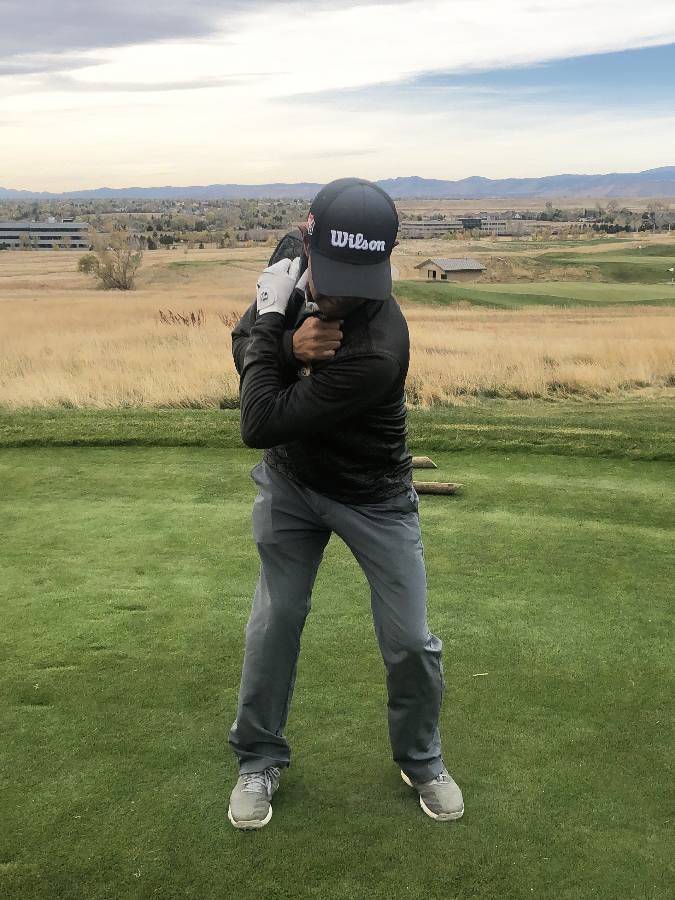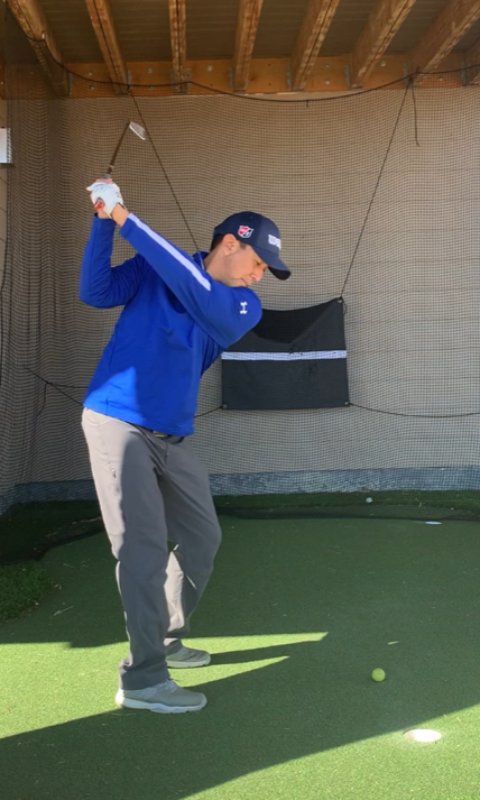The golf swing transition is the process of when the downswing occurs after the backswing. This is very important because it decides how you will proceed with the downswing. This small and subtle move can decide your tempo and create the proper sequence for the body to move in the proper ways. It can also give you more control and feel of what your body is doing. This is what separates great players to good players. It’s all about being in control of your swing so you can become a better ball striker with a consistent golf swing.
If you created a good backswing of coiling properly and finishing it, we can focus on a few things to help with your transition to start your downswing.
Keep Club Stable
We want to make sure the club is not flopping/dipping in your hands on top of your backswing and we also don’t want to grip the golf club too tight where that’s the only thing we feel at transition so work on that grip pressure to moderately control the golf club.
- Gripping the golf club with moderate pressure can create lag by letting our lower body start our downswing.
- Gripping the golf club with tight pressure will let you bring your arms down first in your backswing and a “rushed” downswing.
Be Patient
When you rush your transition, there’s a good chance you will not feel your lower body initiate your downswing. Being patient can also let your golf club finish the rotation on top so you can start and feel the lower body going ahead. Parts of the lower body like the legs, hips and torso are bigger so it needs time to get going. Being too fast will start your hands and arms.
Find a Trigger Mechanism
When you are performing different movements all in one or even two sequences, it will be easier to create a “checkpoint” to know when you completed one movement and to start another one. That is what great ball strikers do to control their sequence and to generate power and stability all from better timing. So let’s see if you can find that tension to trigger your time to transition into the downswing.
Find that Trigger
If you have a backswing that coils as I discussed, that means that your lower body is active in helping you rotate all the way down to your feet. Tension should be created in your trail leg glute because your upper body turned much more than your lower body. The lower body rotation is moderate but is stable because of the trail hip holding its position while accepting the weight from the upper body rotation. That trail leg should also be fairly bent and holding the same angle from the setup.
Cross your arms
Cross your arms over your chest without a golf club and get in your setup and stance. Rotate like your backswing and see if you can feel tension in your trail side glute.

Lower Body Starts Downswing
There are many parts of your lower body that can be focused on to transition into the downswing. There are different parts to use and every good ball striker uses their own version to get it started correctly. Here are only some that you can use for your transition.
Use your left leg and knee to lead to get to your target side and transfer the weight. You can use that knee as the leader and then use the rest of the lower body to follow.
If you read how to <Turn the Screw>, you will need to learn how to respond to it so you can properly attack the ball on the downswing more naturally. We discussed coiling the shoulders so the torso and hips feel like they are on a downward motion. But after this, we want to discuss what you want to feel every single time you turn that screw. It’s no secret, it’s all about the lower body. We want to use the hips, legs, glutes and feet to put a “Pop” when starting the downswing. This transition is all about finding a trigger so we can create the following…
- Create the proper sequence of using the lower body first (leading hip/knee)
- Create mechanism to know when you completed your body turn
- Feel lower body generate power to use it on the downswing
- Create the downswing shaft plane come under the backswing plane
- Make transition feel comfortable even for a shorter backswing
- Builds a patient swing tempo
So when you Turn the Screw, the upper body coil is to put pressure on the lower body from not turning as much. What happens is that you want to let the lower body feel that it turns last and will finish what the upper body created. The reason for this is not only because of the power generated in the coil back but the angle we want to leave our lower body at including our hip line when we finish the backswing. We do not want to over-rotate our hips as this would cause many problems including your hip line now aiming too far away from your intended target and your hands and club being too far behind your body at the top of your swing.
<pic>
We want to feel a solid base with our lower body feeling balanced and knowing where our weight is distributed in the backswing. Our upper body coils and lower body absorbs that coil. The lower body coils a bit but since they are bigger muscles they only need just a bit.
This means that the legs will feel more bent. The front/left leg (RH) will bend down by having that knee come out towards the ball to support the coil on the way back. This is all caused by the coil in our backswing. That means your entire left side of your body will coil down but keep a bit of weight on that side by pushing down on the left toes/ball of that foot. You will feel your left heel be pulled up a bit by doing this. This will help keep your balance.
<behind PIC> <front PIC>
The back right leg is the one that will absorb most of the weight with our coil. You may feel like you’re going to sit down on the right leg but you’ll just be holding the angle in which you started with at setup. This is it…this is where we find it…the MVP (Most Valuable Piece), the Tom Brady of the Patriots, the Lebron James of all the teams he is going to play for…
When you put it all together…the grip, the setup, the coil, the legs becoming the base…we want to feel what Tiger Woods has felt his entire career, your back GLUTE.
What this means is that you created tension in the back of your right hip or glute in the backswing. If you are coiling down with all the parts as we discussed, your weight is being transferred to that right side. But since you are holding that leg angle which means your right hip will not turn any further, you’re creating tension.
The right leg/hip absorbs most of the weight coming back at it but knows it does not want to over rotate and acts like a dam with some resistance while still holding the weight transferred over. If you were to over-rotate and let the back hip turn with the rest of the body, you would say that the dam broke and is now letting all the water through, losing everything in the swing that you worked for. You will also lose your hip angle, over rotate your body and shoulders, create a new club plane, lose clubhead speed and most importantly, not turn your hips through (most likely your hip will slide not turn).
Top of the Golf Swing Drills
Freeze it, Feel it
When you can pause your swing on the top at transition, you will be able to start your downswing a bit slower which entails you that you can feel all parts of your body and understand your sequence and tempo. Many players rush to hit the golf ball from the top and then lose track of what their swing is supposed to do
Find your Rubber Backstop!
An example I explain to my students is if they understand how a baseball pitcher pitches off a mound. They use a rubber slat that they lean their back foot against so they can feel it when they push off of it to create more power and speed. Just like a pitching mound backstop.
It also gives them a sense of timing as they feel their lower body start the pitch on the way down instead of their hands or upper body. If you put the same pitcher on the mound without a rubber, they will get less power from their lower body and less speed on their pitch.
In the golf swing, we need to find our rubber and backstop. We can’t use a rubber or any aids that will remind us so we have to build it in our backswing and use it as our trigger mechanism to feel every time we take our backswing so we can create a natural downswing by using the lower body properly.
We want to activate your right glute and use that as a trigger or mechanism to always coil back in your backswing to feel that sensation over and over again in your swing. When you do this properly, you will feel like this is your new “back-stop”, you will need to feel that tension in your right hip area before you start your downswing from now on.
This will lead to many many more consistent golf swings in your career. When you feel this, you are ready to unleash power and speed in your backswing!


